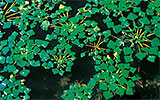Eutrophication
Excessive amounts of nutrients were discharged into the water bodies within the Danube River Basin starting with the 1960s and peaking in the late 1980s. Since then these discharges declined. They originate from domestic and from agricultural sources.
These excess nutrients cause intensified growth of plant life in water (eutrophication), and thus can disturb the ecological balance in the river network and the Black Sea. The water can become murky and can be filled with algal blooms. Entire food webs, including valuable fish stocks, can be seriously affected by eutrophication.
Did you know?
Without adequate amounts of nutrients only a limited quantity of plant growth is possible. But excessive amounts can greatly disturbe the ecological balance of the Danube, its tributaries, and also the Black Sea.
What is eutrophication?
Eutrophic means nutrient-rich, and eutrophication literally means enrichment with nutrients; nowadays the term is more often used in a negative sense to mean over-enrichment. Nutrients - especially nitrogen and phosphorus - are vital for life in the rivers and the sea. But the presence of excessive nutrients can seriously disturb the functioning of ecosystems, especially in lakes, in slowly flowing parts of rivers, and in the Black Sea.
Weather conditions can alleviate or accelerate eutrophication. Mild, wet winters usually accentuate the problems for shallow, coastal waters, as nutrients are washed from farmland into rivers, lakes and ultimately the sea.
Facts and figures
- In 1997 and 2000 the state of eutrophication in the Danube river basin corresponded to class I-III (moderate to serious) of the interim ICPDR target values, while the eutrophication status of the River Sio corresponded to class IV (very serious) . These classifications are based on measured chlorophyll-a concentrations.
- Eutrophication in the Black Sea leads to major changes in marine ecosystems, and hampers many beneficial uses of natural coastal and marine resources.
- Inpropper agricultural activities are a major source of nutrients. Agricultural production is expected to increase in many parts of the Danube Basin after the EU enlargement, which will probably lead to increased nutrient discharges from this sector.
- Inputs of nutrients from urban areas, smaller municipalities and scattered settlements, as well as via atmospheric deposition must also be addressed.
What the ICPDR is doing
The ICPDR is currently assessing nutrient loads and their impacts, using information from the Transnational Monitoring Network, the daNUbs project (Nutrient Management in the Danube Basin and its Impact on the Black Sea), the Joint Danube Survey, and the nutrient emission models of MONERIS. In addition to this an Emission Inventory is regularly updated, collecting data about municipal and agro-industrial pollution.
Disclaimer
The information contained in the ICPDR website is intended to enhance public access to information about the ICPDR and the Danube River. The information is correct to the best of the knowledge of the ICPDR Secretariat. If errors are brought to our attention we will try to correct them.
The ICPDR, expert group members, nor other parties involved in preparation of information contained on this website cannot, however, be held responsible for the correctness and validity of the data and information provided, nor accept responsibility or liability for damages or losses arising directly or indirectly from the use of the information conveyed therein.
Only those documents clearly marked ICPDR documents reflect the position of the ICPDR.
Any links to other websites are provided for your convenience only. The ICPDR does not accept any responsibility for the accuracy, availability, or appropriateness to the user's purposes, of any information or services on any other website.
When using the information and material provided on this website, credit should be given to the ICPDR.

